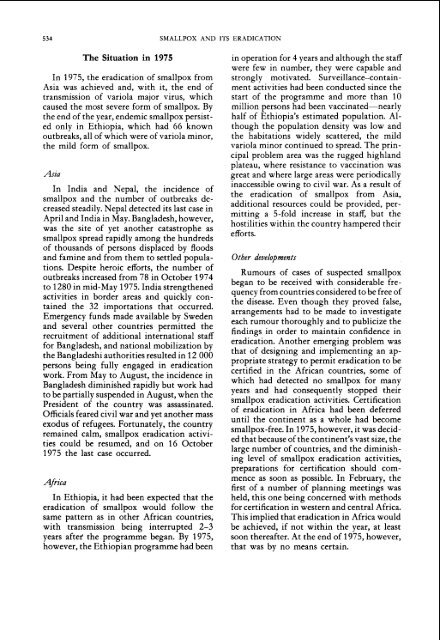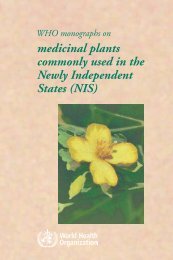smallpox eradication - libdoc.who.int - World Health Organization
smallpox eradication - libdoc.who.int - World Health Organization
smallpox eradication - libdoc.who.int - World Health Organization
Create successful ePaper yourself
Turn your PDF publications into a flip-book with our unique Google optimized e-Paper software.
534 SMALLPOX AND ITS ERADICATION<br />
The Situation in 1975<br />
In 1975, the <strong>eradication</strong> of <strong>smallpox</strong> from<br />
Asia was achieved and, with it, the end of<br />
transmission of variola major virus, which<br />
caused the most severe form of <strong>smallpox</strong>. By<br />
the end of the year, endemic <strong>smallpox</strong> persisted<br />
only in Ethiopia, which had 66 known<br />
outbreaks, all of which were of variola minor,<br />
the mild form of <strong>smallpox</strong>.<br />
Asia<br />
In India and Nepal, the incidence of<br />
<strong>smallpox</strong> and the number of outbreaks decreased<br />
steadily. Nepal detected its last case in<br />
April and India in May. Bangladesh, however,<br />
was the site of yet another catastrophe as<br />
<strong>smallpox</strong> spread rapidly among the hundreds<br />
of thousands of persons displaced by floods<br />
and famine and from them to settled populations.<br />
Despite heroic efforts, the nuAbkr of<br />
outbreaks increased from 78 in October 1974<br />
to 1280 in mid-May 1975. India strengthened<br />
activities in border areas and quickly contained<br />
the 32 importations that occurred.<br />
Emergency funds made available by Sweden<br />
and several other countries permitted the<br />
recruitment of additional <strong>int</strong>ernational staff<br />
for Bangladesh, and national mobilization by<br />
the Bangladeshi authorities resulted in 12 000<br />
persons being fully engaged in <strong>eradication</strong><br />
work. From May to August, the incidence in<br />
Bangladesh diminished rapidly but work had<br />
to be partially suspended in August, when the<br />
President of the country was assassinated.<br />
Officials feared civil war and vet another mass<br />
exodus of refugees. Fortunately, the country<br />
remained calm, <strong>smallpox</strong> <strong>eradication</strong> activities<br />
could be resumed, and on 16 October<br />
1975 the last case occurred.<br />
Africa<br />
In Ethiopia, it had been expected that the<br />
<strong>eradication</strong> of <strong>smallpox</strong> would follow the<br />
same pattern as in other African countries,<br />
with transmission being <strong>int</strong>errupted 2-3<br />
years after the programme began. By 1975,<br />
however, the Ethiopian programme had been<br />
in operation for 4 years and although the staff<br />
were few in number, they were capable and<br />
strongly motivated. Surveillance-containment<br />
activities had been conducted since the<br />
start of the programme and more than 10<br />
million persons had been vaccinated-nearly<br />
half of Ethiopia's estimated population. Although<br />
the population density was low and<br />
the habitations widely scattered, the mild<br />
variola minor continued to spread. The principal<br />
problem area was the rugged highland<br />
plateau, where resistance to vaccination was<br />
great and where large areas were periodically<br />
inaccessible owing to civil war. As a result of<br />
the <strong>eradication</strong> of <strong>smallpox</strong> from Asia,<br />
additional resources could be provided, permitting<br />
a 5-fold increase in staff, but the<br />
hostilities within the country hampered their<br />
efforts.<br />
Other developments<br />
Rumours of cases of suspected <strong>smallpox</strong><br />
began to be received with considerable frequency<br />
from countries considered to be free of<br />
the disease. Even though they proved false,<br />
arrangements had to be made to investigate<br />
each rumour thoroughly and to publicize the<br />
findings in order to ma<strong>int</strong>ain confidence in<br />
<strong>eradication</strong>. Another emerging problem was<br />
that of designing and implementing an appropriate<br />
strategy to permit <strong>eradication</strong> to be<br />
certified in the African countries, some of<br />
which had detected no <strong>smallpox</strong> for many<br />
years and had consequently stopped their<br />
<strong>smallpox</strong> <strong>eradication</strong> activities. Certification<br />
of <strong>eradication</strong> in Africa had been deferred<br />
until the continent as a <strong>who</strong>le had become<br />
<strong>smallpox</strong>-free. In 1975, however, it was decided<br />
that because of the continent's vast size, the<br />
large number of countries, and the diminishing<br />
level of <strong>smallpox</strong> <strong>eradication</strong> activities,<br />
preparations for certification should commence<br />
as soon as possible. In February, the<br />
first of a number of planning meetings was<br />
held, this one being concerned with methods<br />
for certification in western and central Africa.<br />
This implied that <strong>eradication</strong> in Africa would<br />
be achieved, if not within the year, at least<br />
soon thereafter. At the end of 1975, however,<br />
that was by no means certain.
















